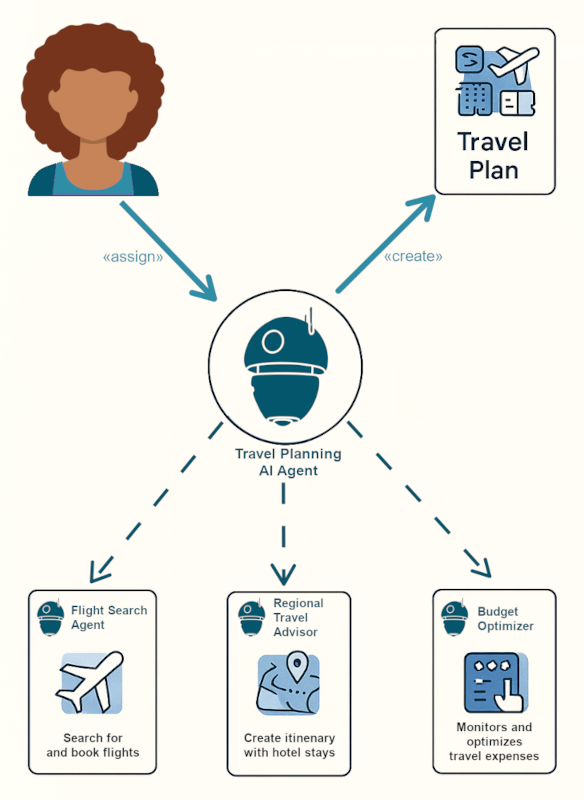Model Context Protocol: Enabler For Agentic AI
Author: Stephan Roth | Category: AI | Published on: August 08, 2025
Agentic AI could mark a paradigm shift for the internet as we know it today. Agentic AI has the potential to transform the internet from a largely user-driven ecosystem into one where autonomous AI agents transact, communicate, and collaborate on behalf of humans. The Model Context Protocol (MCP) could play an important role in this.
From Agentic AI to the Agentic Web
Autonomous AI agents, so-called Agentic AI, are currently considered the next evolutionary step in the development of artificial intelligence. The term Agentic AI refers to AI-powered software systems that are pursuing goals, making decisions, and interacting with digital and real-world environments without constant human oversight. This means that, for instance, people can send an AI agent on a mission with a defined goal, such as planning a trip and organizing both transportation (e.g., booking flights) and accommodations.
This evolutionary step lays the foundation for a future state of the internet that a group of researchers from different institutes formally defined as the “Agentic Web”:
The Agentic Web is a distributed, interactive internet ecosystem in which autonomous software agents, often powered by large language models, act as autonomous intermediaries that persistently plan, coordinate, and execute goal-directed tasks. In this paradigm, web resources and services are agent-accessible, enabling continuous agent-to-agent interaction, dynamic information exchange, and value creation alongside traditional human-web interactions.
A crucial detail in this definition of the Agentic Web is the term “agent-accessible.” It means: We have to provide a simple way to give AI agents the context they need. At this point, the Model Context Protocol comes into play.
Model Context Protocol: USB-C for AI Integrations
The Model Context Protocol (MCP) is an open standard and open-source framework developed by Anthropic PBC, a US-American Public Benefit Corporation which also developed the well-known LLM Claude. The goal of MCP is to standardize how AI systems, particularly large language models (LLMs), interact with external tools, systems, and data sources. With this standardized protocol, AI agents can be enabled to query real-time data and information from their context, as well as influence (manipulate) this context. For this reason, MCP is sometimes referred to as the “USB-C for AI integrations”.

Example Use Case: Planning and Booking a Trip
Just imagine, someone wants to plan and book a two-week trip through Italy. Instead of doing this manually by herself, she assigns an AI agent to do it for her, including flights, accommodation, transportation, and cultural activities. This primary agentic AI assistant uses MCP to orchestrate multiple specialized AI models. The primary agent decomposes its mission into sub-tasks: flight booking, itinerary planning, hotel selection, and budget optimization. Using MCP, it dynamically selects and invokes appropriate sub-agents, e.g., a flight search model, a regional travel advisor, a hotel recommender, and so on. Each of this sub agents have clearly defined roles and context boundaries. The sub-agents exchange structured updates and plans using MCP’s standardized metadata format. For example, the flight agent updates departure dates, which the itinerary agent then uses to reschedule tours. The budget model continuously monitors cost implications and proposes trade-offs in real time. Once all components are finished, the primary agent validates the end-to-end plan with the user. Upon approval, it triggers a booking sequence via a transaction execution agent. The final result is a personalized, optimized, and efficiently coordinated travel plan completed with minimal user input.
How to Start With MCP?
The website modelcontextprotocol.io operated by Antropic PBC provides everything you need to use MCP: an architectural overview (basically, MCP has a simple Client-Server-Architecture), comprehensive documentation, tutorials, and various SDKs (Source Development Kits) for different programming languages, including Java, C#, Python, and TypeScript. You can find a lot of pre-built MCP servers for popular tools like GitHub, Google Drive, Slack, Linkedin, Youtube, Tripadvisor, NASA's Image Server, or PubMed using the MCP Archive, or through this well-maintained list of more than 1.000 reference implementations on GitHub.
MCP also opens up a whole range of innovative possibilities with regard to Model-Based Systems Engineering (MBSE). The new, standardized API (as reported in this blog article) from SysML 2.0 enables an MCP server to be offered for accessing a model repository—and thus querying and manipulating a system's model data by an AI agent. I will address this topic in more detail in the future and then report back here. Stay tuned!